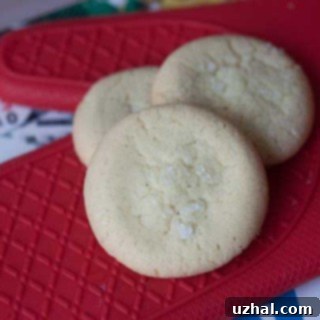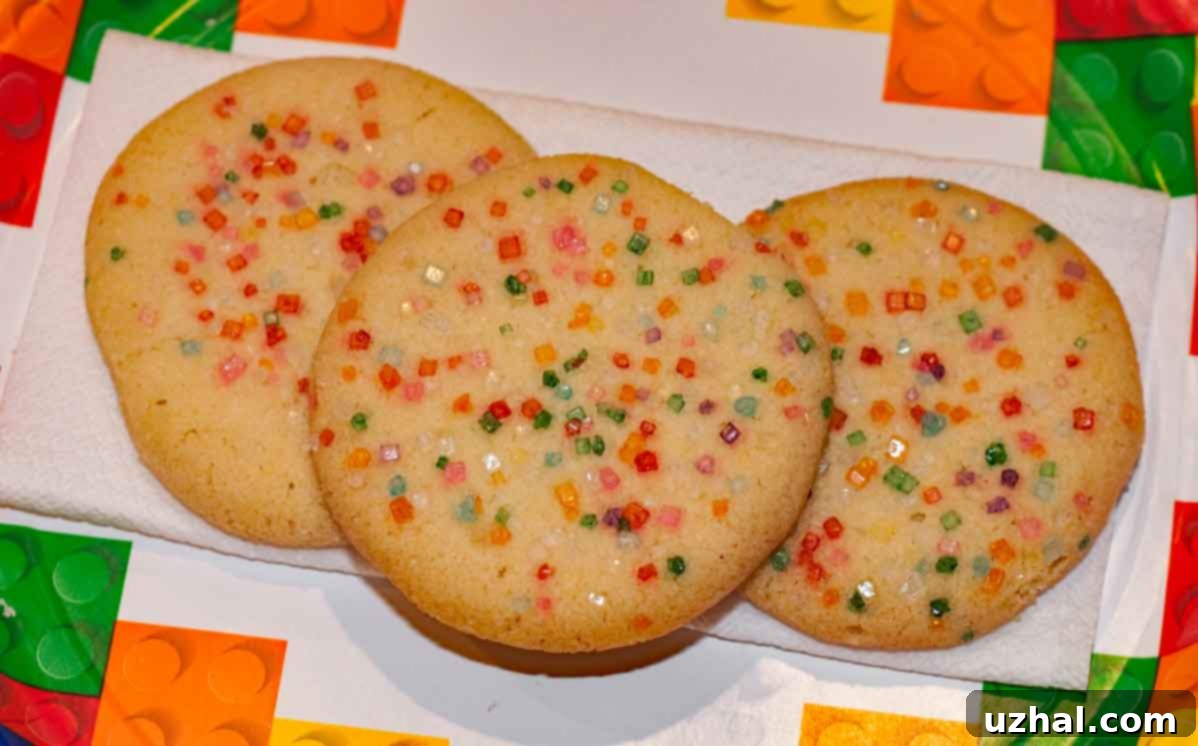The Ultimate Guide to Crisp Sugar Cookies: Unlocking Perfect Texture with Lard, Butter, and Shortening
There’s an undeniable joy in biting into a perfectly crisp sugar cookie – that satisfying snap, followed by a delicate, melt-in-your-mouth texture. For many home bakers, achieving this ideal crispness is a quest, often experimented with different fats and techniques. While butter is a beloved staple for its flavor, an often-overlooked ingredient, lard, can truly revolutionize your sugar cookie game, delivering an unparalleled lightness and crackle that simply can’t be matched.
Our journey to the ultimate crisp sugar cookie led us to an intriguing discovery: the transformative power of leaf lard. While you certainly don’t *have* to use leaf lard – delicious crisp sugar cookies can also be made with 100% European-style butter, or a balanced blend of butter and shortening – the difference with lard is truly remarkable. These aren’t just good cookies; they are the lightest, most crackly, and exquisitely crisp sugar cookies we’ve ever baked.
The Unexpected Secret: Baking with Lard for Superior Crispness
Using leaf lard in a sweet recipe might sound unconventional, and we admit to a moment of hesitation. The raw dough, initially, carried a subtle meaty aroma, prompting concerns about whether this flavor would persist after baking. Thankfully, these fears were unfounded. The “meaty” scent completely vanished during the baking process, leaving behind only the most delicate, buttery-sweet aroma and an astonishingly crisp texture.
What makes lard, particularly high-quality leaf lard, such a game-changer for sugar cookies? It boils down to its unique properties:
- Fat Crystal Structure: Lard has larger fat crystals compared to butter or shortening. When incorporated into dough, these crystals create tiny pockets of air and steam during baking. As the cookie bakes, the fat melts, leaving behind a more open, tender, and incredibly crisp crumb.
- Lower Melting Point: Lard melts at a lower temperature than shortening, allowing it to spread more readily in the oven. This contributes to thinner, wider cookies with a desirable crisp edge.
- Less Water Content: Unlike butter, which contains about 15-20% water, pure lard is virtually 100% fat. This lack of water means less steam is produced, reducing gluten development and resulting in a more tender and fragile cookie that’s less prone to chewiness and more inclined towards crispness.
- Neutral Flavor (with refined lard): While unrendered lard can have a distinct flavor, properly rendered or commercially refined lard (like leaf lard or certain brands of shortening-like lard) has a remarkably neutral taste that allows other flavors, like vanilla, to shine.
The stellar results achieved with these cookies weren’t solely due to the lard, but rather a harmonious combination of factors. This included the specific blend of fats used, the vigorous amount of beating the mixture received, the intentional absence of egg whites (which can lead to a chewier cookie), and the consistently high quality and protein count of flours like King Arthur all-purpose flour. Each element played a crucial role in crafting their exquisite texture and flavor.
A Comparative Analysis: Butter vs. Shortening vs. Lard
To truly appreciate the unique qualities of lard, it’s helpful to understand how it stacks up against other common baking fats:
Butter: The Flavor King (with a few caveats for crispness)
When making cookies with 100% European-style butter, the results are undeniably delicious, yielding a light and crisp cookie with a rich, complex flavor. European-style butter, with its higher fat content (typically 82-84%) compared to standard American butter (around 80%), contributes to a more tender crumb and richer taste. However, we observed that butter-only cookies didn’t spread into perfectly uniform circles quite as effortlessly as those made with lard or a butter-lard blend. Furthermore, their centers tended to be a tad bit denser and slightly less crisp than their lard-infused counterparts. This is often attributed to butter’s higher water content and slightly different melting properties, which can promote more gluten development and less spread.
Shortening: The Spreading Champion
Vegetable shortening has long been a baker’s secret weapon for achieving perfect cookie spread and a tender, melt-in-your-mouth texture. It’s 100% fat, contains no water, and has a higher melting point than butter, allowing cookies to hold their shape a bit longer before spreading, resulting in a more even, flatter cookie. For many, a combination of butter (for flavor) and shortening (for texture and spread) represents the most practical and consistently reliable option for crisp sugar cookies. This blend offers the best of both worlds, providing a good balance of taste and structural integrity.
Lard: The Ultimate Crispness Enhancer
As discussed, lard introduces a level of crispness and lightness that is difficult to replicate with other fats. Its unique properties yield cookies that are not just crisp but also delicate and almost airy. While initial concerns about flavor can arise, especially with less refined lard, the right type of lard (like leaf lard or specifically processed baking lard) offers a neutral flavor profile that enhances texture without imposing unwanted tastes. The results are truly superior, creating a sugar cookie experience that stands out from the crowd.
Beyond the Fat: Essential Techniques for Perfect Sugar Cookies
While the choice of fat is paramount, several other factors contribute significantly to the ultimate success of your crisp sugar cookies:
- The Creaming Method: The vigorous beating of cold butter (or fat blend) with sugar is crucial. This process incorporates air into the mixture, which creates lightness and helps with the cookie’s spread and texture. Beating for several minutes, as specified in the recipe, ensures sufficient aeration and a light, creamy base.
- Egg Yolks Only: Our recipe specifically calls for large egg yolks and omits the egg whites. Egg yolks are rich in fat, which contributes to tenderness, richness, and a desirable golden hue. Egg whites, on the other hand, are primarily protein and water. Including them could introduce too much moisture, promoting gluten development and potentially leading to a tougher, chewier cookie rather than the desired crispness.
- Quality Flour Matters: The type and quality of your flour also play a role. Using a consistent, good-quality all-purpose flour, such as King Arthur flour, ensures a reliable protein count. This impacts gluten formation and the overall structure of the cookie, contributing to its delicate crispness without making it too crumbly. Weighing your flour (or using the spoon-and-level method) is key to consistent results, as too much flour can lead to dry, stiff cookies.
- Low and Slow Baking: Baking at a lower temperature (300°F) for a slightly longer duration allows the cookies to bake through evenly and crisp up without browning too quickly. This gentle heat ensures a uniform texture from edge to center and prevents a soft, underbaked interior.
Morrell Snow Cap Lard: A Reliable and Odorless Option
Following a helpful comment from a reader named Marilyn, we experimented with Morrell Snow Cap lard in combination with regular salted Wegman’s brand butter (not European style). The results were just as crispy and delicious! A significant advantage of Snow Cap lard, especially for those sensitive to the initial aroma of unrendered or less refined lards, is its virtually odorless nature. Unlike some lards, even those from a pie shop, Snow Cap presented no meaty smell whatsoever, making the baking process even more pleasant and worry-free.
Marilyn’s advice also included a valuable technique: pressing the dough down slightly to form disks rather than baking them as perfect balls. This simple step can contribute to a more even spread and a consistently flatter, crispier cookie, ensuring every bite delivers that delightful snap. It’s a small adjustment that makes a big difference in achieving that professional-looking, uniformly crisp cookie.
Related Cookie Adventures
- Leaf Lard Ginger Cookies
- Crisp and Thin Peanut Butter Cookies
- Hazelnut Butterscotch Oatmeal Crisps
- Tiny Chocolate Chip Cookies
- Crisp Sugar Cookies (Original Version)
Recipe: Light Crisp Sugar Cookies

Light Crisp Sugar Cookies
Cookie Madness
Pin Recipe
Ingredients
- ⅓ cup cold salted European style butter cool room temperature (75 grams)
- ⅓ cup vegetable shortening 65 grams or good quality leaf lard (75 grams)
- 1 ⅓ cups granulated sugar 260 grams
- 2 large egg yolks
- ¼ teaspoon salt it doesn’t seem like a lot, but the cream of tartar adds some saltiness
- 1 teaspoon good vanilla
- 1 ⅓ cups all-purpose flour 170 grams, weigh or spoon and scoop
- ¾ scant teaspoon baking soda
- ¾ scant teaspoon cream of tartar
- Coarse or sparkly sugar optional
Instructions
-
Preheat the oven to 300 degrees F. Have ready two foil lined or ungreased baking sheet.
-
Cut the cold butter into thin slices and put it in a large mixing bowl with the shortening or lard. Beat cold butter with an electric mixer until light and creamy. Add the sugar and beat for about 3 minutes, scraping the sides of the bowl often. Add the egg yolks and continue beating for another 2 minutes, scraping the sides of the bowl. Beat in the salt and vanilla and beat for another minute.
-
Mix the flour, baking soda and cream of tartar together in a separate bowl, then gradually stir into the whipped egg mixture until a soft dough forms. Shape the dough into 30 or 32 one inch balls. Chill the dough balls or bake immediately.
-
Dip tops of dough balls in sugar and place on a foil lined baking sheet spacing about 2 ½ inches apart. Bake at 300 for about 20 minutes or until the cookies appear set and just slightly brown around the edges. Sprinkle a little more sugar on top as soon as they come out of the oven.
-
Let cool on baking sheet for a minute or two, then transfer to a wire rack and let cool and crisp.
Whether you choose to embark on the lard adventure or stick to the tried-and-true butter and shortening combination, this recipe and the insights shared will guide you to baking truly exceptional crisp sugar cookies. Experiment, enjoy the process, and savor every delightful, crackly bite!
